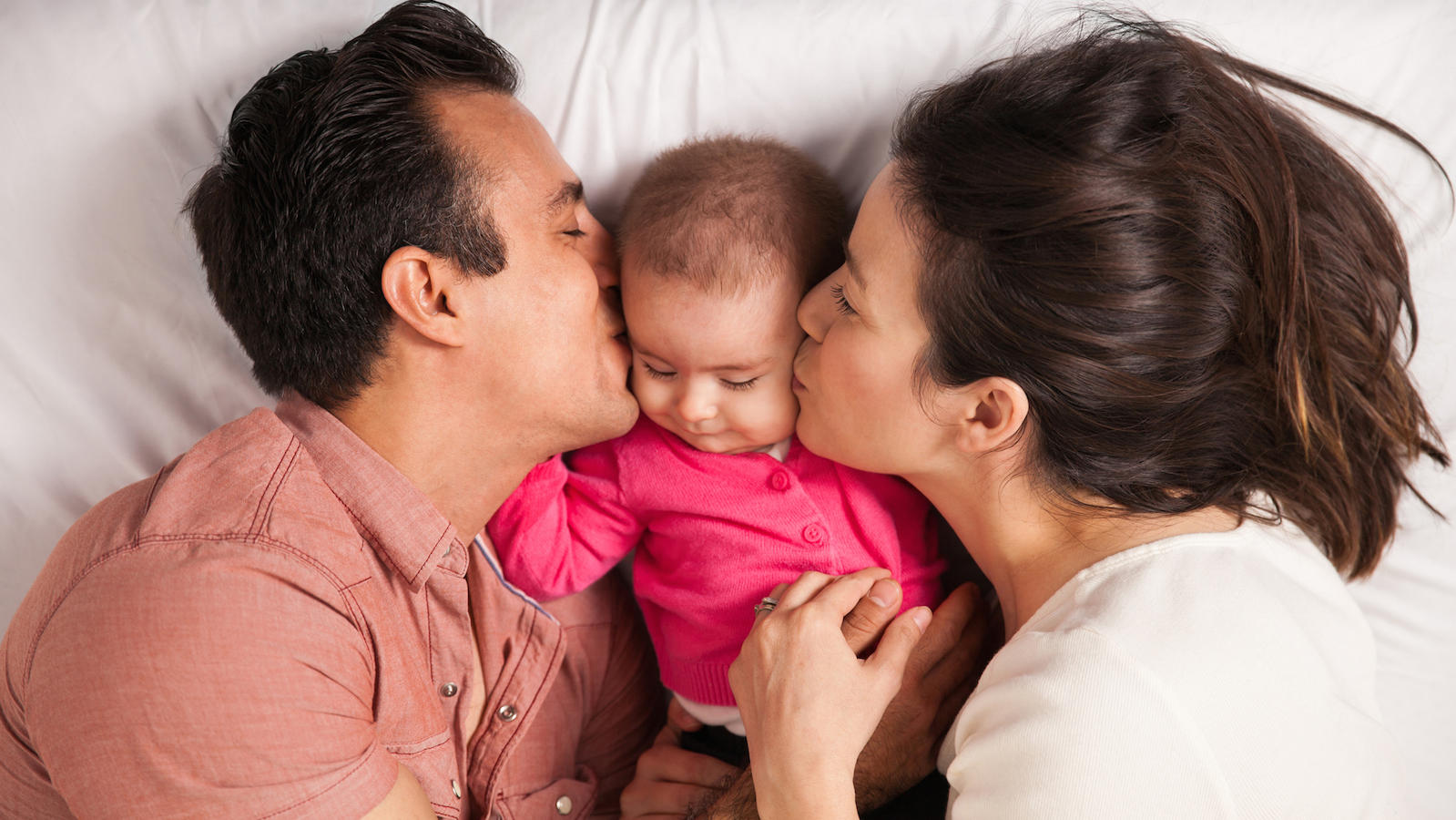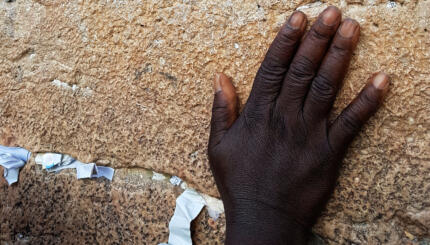For more about Jewish parenting, visit our partner site, Kveller.
For help choosing a Jewish name, check out Kveller’s Baby Name Finder.
Today there is a good chance that someone special in your life who isn’t Jewish will be at your bris ( ), simchat bat, or other welcoming ceremony for your new baby. It may be an aunt or uncle, grandparents, or even yourself or your partner: a non-Jewish parent who has pledged to raise this child in a Jewish home.
Both parents will obviously be involved in the planning of your ceremony, and to a certain extent can tailor it to their personal comfort level. For example, how much is said in English versus Hebrew, how much is focused on the idea of the covenant between God and the Jewish people, and how much focuses on more universalistic Jewish ideas and traditions. Welcoming ceremonies for girls, which are a relatively new phenomenon, are not “fixed” as the ancient rite of brit milah, and so there is often far more room for flexibility.
With your help, My Jewish Learning can provide endless opportunities for learning, connection and discovery.
For mohels — ritual circumcisers (who are in most cases Orthodox) — the mother’s religion is the one that counts when determining if the baby is Jewish according to Jewish law. Ritual circumcision is actually a requirement that a Jewish father must fulfill — or delegate — when he has a son. Part of a traditional brit milah involves the father reciting a line in Hebrew that delegates that responsibility to the mohel. When the father isn’t Jewish, the obligations of traditional Judaism do not bind him, and so the mohel will skip that line. If the baby’s mother is not Jewish, then a traditional mohel will likely agree to perform the circumcision if it is “l’shem gerut” — with the intention that the baby will later be immersed in a (a ritual bath) to be converted to Judaism. Reform mohels will, in line with current Reform thinking, consider the baby Jewish if either parent is Jewish.
It will be important to discuss the family’s circumstances with the mohel in advance of the day of the ceremony, and clarify with him which roles you wish to assign to various relatives. It is then that you should ask him about the role that a non-Jewish parent can play.
The honorary roles of carrying the baby into the room for his brit milah and holding him before the mohel does the actual cutting are often given to the grandparents of the new baby. While a rigorously Orthodox mohel may insist that the sandek, the man who holds the baby, be Jewish, there is likely to be no objection to a non-Jewish grandmother carrying the baby into the room.
There is a lot more room for creative inclusion of a non-Jewish parent or other family member at a simchat bat, a ritual Jewish baby naming event for girls.
Other non-Jewish family members, uncertain about what to expect or their role in the ritual, can feel uncomfortable at a Jewish ritual event. Since it is important that everyone feel welcome, you can alleviate those feelings by explaining to them in advance what will take place, and even take it a step further by making sure that they have an important part in your daughter’s rite of passage. There are several ways in which they can be included with roles integral to the ceremony. As will be the case 13 years down the road at the child’s bar or bat mitzvah, there are on this occasion certain roles which both non-Jews and Jews can fill, and others that are most appropriately handled by Jews.
Even before getting to the ritual elements, there are many ways to acknowledge the background of both sides of the family at your celebration, which can include explicit recognition of a non-Jewish parent’s heritage.
At one ceremony held at San Francisco’s Congregation Sha’ar Zahav, for example, the baby wore a handmade christening gown which had been passed down as a family heirloom for several generations. While to some that might seem out of place at a Jewish ceremony, the public acknowledgment of this mother’s non-Jewish heritage helped make it possible for her to fully commit to raising her children as Jews, because her own past was not being rendered invisible.
The décor for the day adds more opportunities: red, a color which in China represents good fortune, can be used for flowers and tablecloths if part of the child’s background is Asian; if the family is of African heritage, lengths of mud- or kente cloth can be used. You can also include food from the culture of the non-Jewish part of the family at the party immediately following the ceremony; these days, it’s not hard to provide vegetarian or even kosher Italian, Irish, African, and Asian foods, for example.
Yet another way to incorporate some of the non-Jewish culture which may be part of your child’s heritage is to include relevant songs from that tradition.
Both parents should stand in the front of the room in which the ceremony is being held, and welcome their guests. If one isn’t Jewish, and the Jewish parent will have more involvement in the ritual aspects, then the non-Jew might be the one to start the day off with a few words to orient people to what they will be witnessing.
A non-Jewish parent, along with non-Jewish grandparents, can offer personal thoughts about the meaning of this baby’s arrival in their family’s life. Similarly, they can speak about the person after whom the baby has received her English or Hebrew name, if that person was from their side of the family (for example, one girl named after her Irish Catholic great-aunt Elizabeth received the Hebrew name Elisheva). Both are simple ways to seamlessly integrate the participation of non-Jewish loved ones.
Non-Jewish family members can also honor and celebrate the baby by reading something related to her arrival during the ceremony. It might be a contemporary poem, a prose passage from a favorite book, or even a section of text from the Torah translated into English, like one of the Psalms. Many different sources can be appropriate so long as they don’t refer to another faith. And of course, it is important to discuss your plans and needs with the mohel (if it’s a bris), rabbi or cantor, or other officiant(s) before the ceremony.
An additional way to thoughtfully include non-Jewish relatives, particularly grandparents, is to express your appreciation to them as you close your welcoming ritual by saying something like, “We thank Patrick’s parents for lending their love and presence to this holy moment in the life of our baby and their grandchild.”
The birth of a baby can have a marvelously healing effect on relationships, and it is the right time to be as inclusive as possible. At the same time, this is a Jewish child being welcomed into God’s covenant with the Jewish people with a specifically Jewish ritual, and so there are roles which are appropriate only for Jews to fill, like reciting Jewish prayers and Hebrew blessings.
A child’s birth is a time fraught with intense emotion. If this baby has non-Jewish family members, her or his ceremony–potentially a time of great healing, but also of great complexity–may be one of the very first Jewish rituals in which they’re being involved.
The occasion may force the baby’s parents to examine seriously, for the first time, which religious community they intend to be part of as a family. That is a discussion best begun–and concluded–long before the baby arrives. While agreeing to raise their child in a Jewish home, the non-Jewish parent may also feel a deep sense of loss, even if they haven’t been particularly religious themselves.
For non-Jewish grandparents, as painful as the marriage of their presently or formerly non-Jewish child to a Jew may have been for them, even that may not have had the sense of permanence for them as does a ritual making clear that their grandchild will be raised as a Jew–and not in their own tradition or faith. If non-Jewish grandparents feel ambivalent about this new child being raised as a Jew, those feelings may well come up during the planning of the child’s ceremony.
Be prepared to handle their concerns with compassion and sensitivity. You don’t want difficult feelings to get in the way of the joyous celebration of your new daughter’s arrival. At the same time, if you and your spouse have made a commitment to raising your child as a Jew, there isn’t room for the birth-related rites of passage, like baptism, of another faith. Simply acknowledging the grandparents’ ambivalence and feelings of loss may be helpful.
This event is an opportunity for non-Jewish relatives to see the beauty of the religion to which you have committed your family, and also an opportunity to involve them and, in the process, demonstrate that choosing a Jewish life for your children does not mean severing family ties with them. For a non-Jewish parent, this may be the first time that you are making a public statement about the way in which you intend to raise your family, and can serve as a joyful affirmation of the commitment you have made to your new–and growing–family.
For more about Jewish parenting, visit our partner site, Kveller.
kosher
Pronounced: KOH-sher, Origin: Hebrew, adhering to kashrut, the traditional Jewish dietary laws.
Torah
Pronunced: TORE-uh, Origin: Hebrew, the Five Books of Moses.



